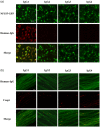The prevalence of anti-neurofascin-155 antibodies in patients with neuromyelitis optica spectrum disorders
- PMID: 33998675
- PMCID: PMC8446398
- DOI: 10.1111/cei.13617
The prevalence of anti-neurofascin-155 antibodies in patients with neuromyelitis optica spectrum disorders
Abstract
Anti-neurofascin-155 (NF155) antibodies have been observed in two cases with neuromyelitis optica spectrum disorders (NMOSD). This study investigated the prevalence of anti-NF155 antibodies in patients with NMOSD and the clinical features of anti-NF155 antibody-positive patients. Sera from 129 patients with NMOSD were screened with anti-NF155 antibodies by cell-based assay (CBA) and re-examined using immunostaining of teased mouse sciatic nerve fibres. Fifty-six patients with multiple sclerosis (MS) and 50 healthy controls (HC) were also enrolled for detecting anti-NF155 antibodies. A total of 12.40% (16 of 129) of patients with NMOSD were positive for anti-NF155 antibodies confirmed by both CBA and immunostaining. Immunoglobulin (Ig) G1 was the predominant subclass. However, none of 56 MS patients or 50 HC were positive for anti-NF155 antibodies. Anti-NF155 antibody-positive NMOSD patients had a higher proportion of co-existing with autoimmune diseases (p < 0.001) and higher positive rates of serum non-organ-specific autoantibodies, including anti-SSA antibodies (p < 0.001), anti-SSB antibodies (p = 0.008), anti-Ro-52 antibodies (p < 0.001) and rheumatoid factor (p < 0.001). Five anti-NF155 antibody-positive NMOSD patients who took part in the nerve conduction study showed mildly abnormal results. Differences in some nerve conduction study parameters were observed between anti-NF155 antibody-positive and negative patients. Anti-NF155 antibodies occurred in a small proportion of NMOSD patients. Anti-NF155 antibody-positive NMOSD patients tended to co-exist with autoimmune diseases.
Keywords: anti-neurofascin-155 antibodies; autoimmune diseases; demyelination; neuromyelitis optica spectrum disorders.
© 2021 British Society for Immunology.
Conflict of interest statement
The authors declare that they have no competing interests.
Figures


References
-
- Weinshenker BG, Wingerchuk DM. Neuromyelitis spectrum disorders. Mayo Clin Proc. 2017;92:663–79. - PubMed
-
- Lennon VA, Wingerchuk DM, Kryzer TJ, Pittock SJ, Lucchinetti CF, Fujihara K, et al. A serum autoantibody marker of neuromyelitis optica: distinction from multiple sclerosis. Lancet. 2004;364:2106–12. - PubMed
-
- Wingerchuk DM, Lennon VA, Lucchinetti CF, Pittock SJ, Weinshenker BG. The spectrum of neuromyelitis optica. Lancet Neurol. 2007;6:805–15. - PubMed
-
- van Pelt ED, Wong YYM, Ketelslegers IA, Hamann D, Hintzen RQ. Neuromyelitis optica spectrum disorders: comparison of clinical and magnetic resonance imaging characteristics of AQP4‐IgG versus MOG‐IgG seropositive cases in the Netherlands. Eur J Neurol. 2016;23:580–7. - PubMed
Publication types
MeSH terms
Substances
Grants and funding
LinkOut - more resources
Full Text Sources
Other Literature Sources
Research Materials

